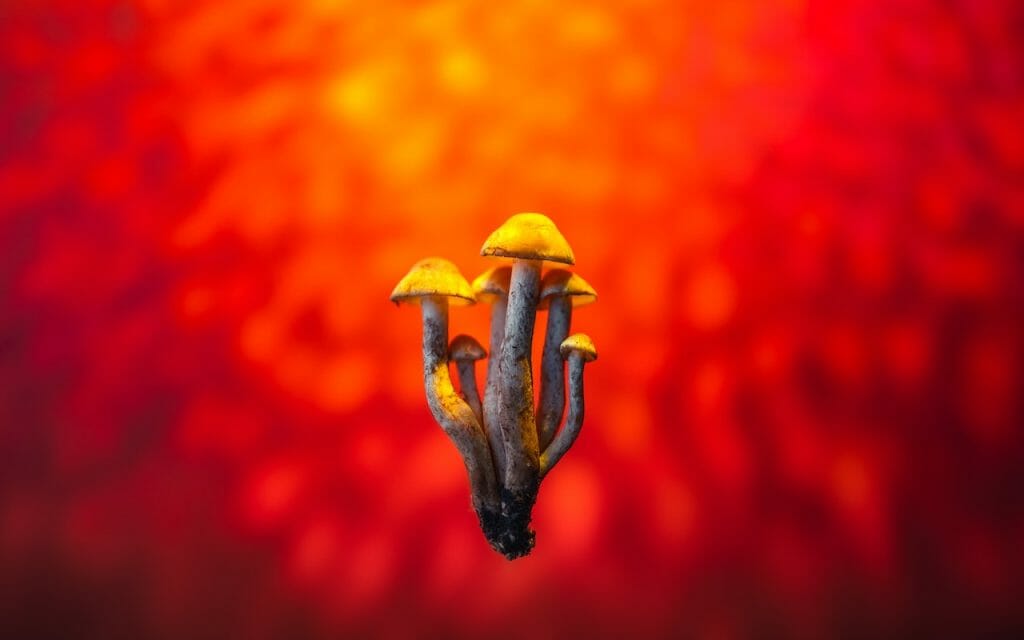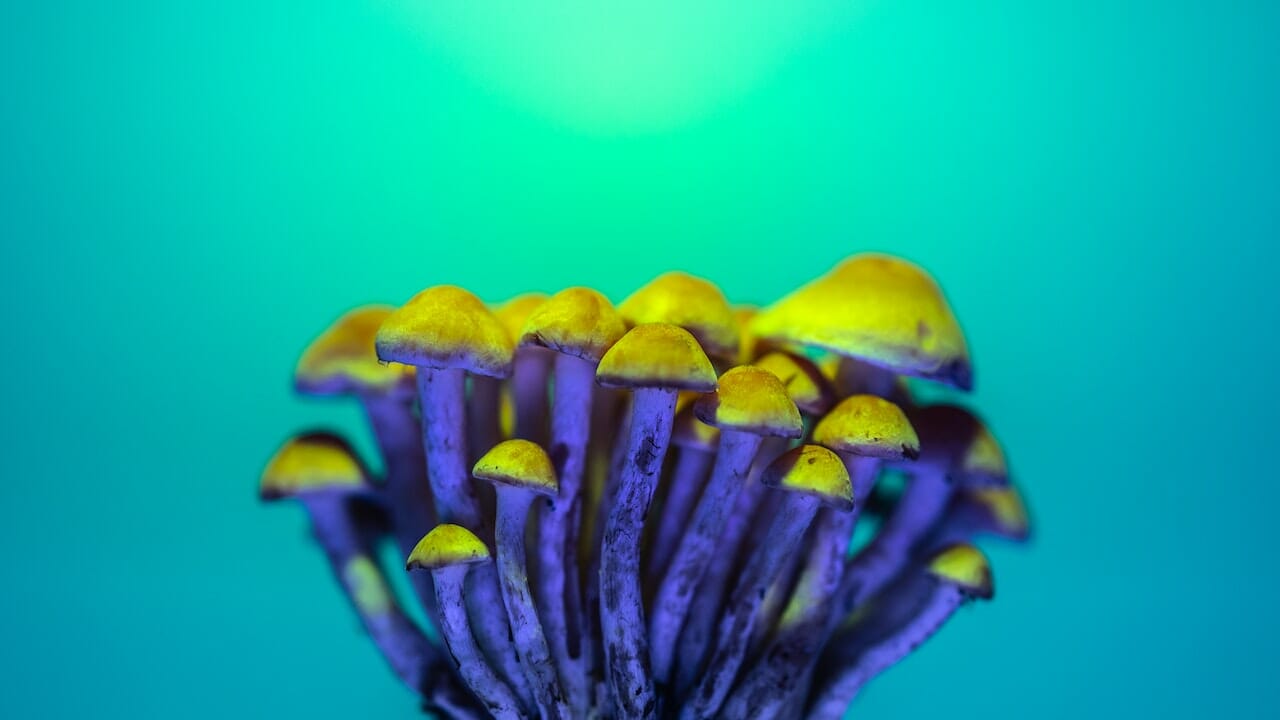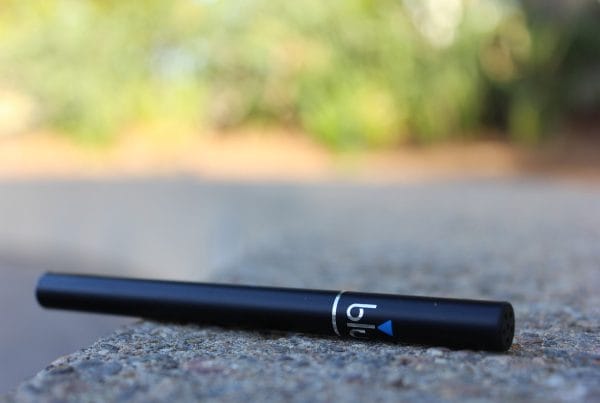Lysergic Acid Diethylamide (LSD) is a highly potent hallucinogen that has been extensively studied. Initially, it was predominantly used for recreational purposes, but it has evolved into a psychoactive compound with potential mental health benefits. This change in understanding has sparked increased interest in studying the effects of easily consumable forms of LSD, like LSD edibles.
Key Takeaways:
- LSD, a powerful hallucinogen, is derived from the ergot fungus.
- LSD shares similarities with psilocybin and interacts with 5-HT2A receptors.
- LSD can cause changes in vision, mood shifts, ego dissolution, and pseudo-hallucinations.

Demystifying LSD
LSD is a remarkably potent hallucinogen that can significantly alter one’s perception of reality and greatly distort sensory experiences. LSD is derived from “ergot,” a type of fungus that grows on rye and other grains.
At its core, LSD is a complex chemical belonging to the ergoline family. It is composed of a bicyclic hexahydroindole group and a bicyclic quinoline group (lysergic acid). The name ‘Lysergic Acid Diethylamide’ is derived from the functional group attached to its core structure. LSD’s structure is similar to other ergoline alkaloids, such as ergotamine, found in the ergot fungus Claviceps purpurea, and the neurotransmitter serotonin.
The Effects of LSD
Once consumed, LSD infiltrates the brain and sets off chemical reactions that can persist for several hours. LSD may induce the following short-term effects:
- Unpredictable mood fluctuations
- Alteration of perceptions
- Feeling dizzy
- Decreased appetite
- Difficulty in controlling movements
The Advantages What Are the Potential Benefits of Using LSD?
The benefits of LSD vary greatly and largely depend on the dose taken. Most studies emphasize the potential advantages associated with consuming smaller amounts of this psychedelic substance. Let’s explore some of the positive impacts linked to LSD consumption.
Pain Management and Promotion of Neuronal Growth
Researchers at Maastricht University discovered that a single microdose of LSD can produce pain-relieving effects that endure for at least five hours, if not more.
During the Cold Pressor Test, a procedure where participants immerse their hands in 3°C (37.4°F) water for as long as possible, those who had ingested 20 mg of LSD managed to keep their hands submerged for 20% longer than those who hadn’t. They also reported feeling less pain and discomfort.
In addition to this, LSD can aid in the development and proliferation of the 86 billion neurons in our brain. Moderate LSD doses, ranging from 5 to 20 ug, increase the levels of BDNF in blood plasma. This is crucial as mood disorders like depression, which are frequently connected to problems with neuroplasticity, could be mitigated due to LSD’s positive influence on neuronal health.
Improvement of Mental Health
Dr. Robin Carhart-Harris from Imperial College London introduced the entropic brain hypothesis. This theory posits that mental health disorders are often rooted in rigid thought patterns, perpetuated by an excessively active default mode network (DMN). Psychedelic substances such as LSD can interrupt the DMN, enhance brain entropy, and aid in dismantling negative neural pathways while promoting the development of positive ones.
A study involving over 1,000 microdosers reported a decrease in depression symptoms. Another extensive cross-sectional study showed a reduction in negative emotional states and harmful attitudes, along with an enhancement in open-mindedness and cognitive abilities.
Therapeutic Approach for Addiction
A meta-analysis of randomized-controlled clinical trials using LSD in psychiatry concluded that it is most effective in treating alcohol dependency. This conclusion is further substantiated by the positive results reported by numerous patients treated for alcoholism by Humphrey Osmond and at the Spring Grove Hospital Centre during the 1950s and 1960s.
Relief from Anxiety and Depression Towards the End of Life
Research conducted by Dr. Peter Gasser indicates that LSD-assisted psychotherapy assists terminally ill cancer patients in reducing their end-of-life associated anxiety. Additionally, it has been noted to improve the subjective quality of life for these patients. A Phase 2 trial is currently underway to explore the potential benefits of LSD therapy for treating depression.
Exploring LSD Edibles: Ingredients and Manufacturing Process
LSD edibles are a category of food and beverages that contain LSD, a hallucinogenic substance. These edibles come in a wide array of forms, including chocolates, candies, baked goods, and even unique offerings like LSD mints.
Component Breakdown
- LSD: This is the active ingredient responsible for the hallucinogenic effects. It is carefully measured and incorporated into the edible.
- Edible Base: The LSD is usually dissolved or infused into a consumable substance like a gummy, candy, sugar cube, or other edible items. These substances act as the delivery mechanism for the hallucinogenic compound.
- Flavouring and Ingredients: The specific edible product may contain flavourings, sweeteners, and other ingredients to enhance its taste and texture. These might include natural or artificial flavours, colours, and sugars, and they can vary significantly.
Manufacturing Steps:
- LSD Synthesis: The process starts with the chemical creation of LSD. This step requires extensive knowledge of organic chemistry and access to necessary chemicals, equipment, and a laboratory environment.
- Liquid Formulation: Once the LSD is synthesized, it is generally transformed into a liquid solution by dissolving it in a solvent. This solution acts as a concentrated LSD formulation.
- Infusion: The liquid LSD is then infused into an edible substance such as gummy candies, sugar cubes, or blotter paper. The edible medium absorbs the liquid, enabling the LSD to be consumed orally.
The Psychedelic Experience of Consuming LSD Edibles
LSD elicits intense visual effects. Colours may appear more vivid, objects might seem to have halos or rainbows around them, and shapes can appear to transform. Regardless of whether the user’s eyes are open or closed, they may see
Intensely hued, shifting geometric patterns and other visuals are common with LSD use. These perceptual distortions, known as “pseudo-hallucinations”, are understood by users to be the product of the drug, not reality.
LSD provides a means to change one’s awareness of self and environment. It can induce a range of mental states. Thoughts might appear clear and meaningful, or they might seem disconnected from logic. Additional effects might include alterations in how time, distance, and body image are perceived. The boundary between one’s self and the external world could seem less distinct. Some people report synesthesia, such as seeing music or hearing colours.
Suggested LSD Products
There’s a wide variety of LSD edibles available, but it’s vital to buy from a trusted dispensary. You need to verify that the edibles contain LSD and not other substances like PCP, ecstasy, or ketamine.
Deadhead Chemist – LSD Infused Gummies
Deadhead Chemist offers LSD-infused edibles. Each gummy contains 100 micrograms (ug) of LSD and comes in various flavours. Each pack has one gummy which has demonstrated potential benefits for conditions like obsessive-compulsive disorder (OCD), post-traumatic stress disorder (PTSD), alcohol addiction, depression, and cluster headaches.
Deadhead Chemist – Mint Tea
Deadhead Chemist’s raspberry mint tea provides a tastier, more aromatic way to experience LSD’s effects. LSD and other psychedelics act like the serotonin neurotransmitter to enhance the brain’s flow state.
Earthly Delights – Candy Flips
Candy flipping first became popular in the rave culture of the late 1980s. Nowadays, explorers and party enthusiasts continue to enjoy the combination of these two potent substances. Users often report intense feelings of love and unity, along with captivating visual effects like enhanced colours, morphing objects, and intricate geometric patterns.
Concluding Remarks
LSD has long been linked to transformative experiences. With the increase in scientific knowledge about this substance, its popularity has skyrocketed. The introduction of LSD-infused edibles offers a fresh path for individuals. These delicious delights have gained the attention of many. Experiment safely and delightfully with regulated doses of LSD.
Powerful Magic Mushrooms Canada, Canada’s leading supplier of high-quality shrooms online, offers an extensive range of LSD-infused edibles and cannabis products. Explore our collection at your own pace, add your chosen items to your cart, and sit back at home while we handle the delivery. We also provide a variety of psilocybin shrooms, edibles, beverages, and capsules for your convenience. Be sure to check out our LSD delivery page for further details!
Frequently Asked Questions
What sets LSD apart from psilocybin?
FEATURES LSD PSILOCYBIN Origin Semi-synthetic chemical compound Occurs naturally in fungi Available Forms Tabs, microdots, liquid, gummies, blotter paper Dried mushrooms, capsules, teas, chocolates Potency Highly potent, microgram doses (ug) Varies based on mushroom species and preparation Onset and Duration Quick onset (15-60 minutes), shorter duration (3-5 hours) Slower onset (30-60 minutes), moderate duration (4-6 hours)
How can one avoid negative experiences with LSD?
- Choose Your Environment Wisely
- Prepare Your Mindset
- Start with a Small Dose
- Arrange for a Trip Supervisor
- Create a Peaceful Atmosphere
- Apply Deep Breathing and Grounding Techniques
- Accept and Let Go
How long do the effects last?
The effects of the acid start to show between 30-60 minutes after intake. Those who are more sensitive to psychedelics may begin to feel the effects
Within a quarter of an hour, you can start the journey. The realization if you’re under the influence of acid usually kicks in around an hour. The climax of your psychedelic experience is expected to occur around three hours into the journey. During this phase, you might feel like time is standing still and experiences of hallucinations may occur.
Be resilient, it’s typical to feel a sense of detachment from reality during this period. The zenith phase can last for 3 to 5 hours, and it is followed by a decline phase that lasts for another 3 to 5 hours.
How does LSD interact with the human body?
LSD primarily establishes a connection with the brain’s serotonin system by adhering to and stimulating the 5-HT2A receptor. This bond initiates a series of neurochemical and physiological responses. The effects of LSD, which can vary widely, can be influenced by certain factors.
Does LSD exist in forms other than edibles?
Yes, it does. LSD is available in a variety of forms. The four primary types of LSD products are blotter paper, liquid solutions, tablets/microdots, and gelatin sheets.
Suggested Reads:
| FEATURES | LSD | PSILOCYBIN |
| Origin | Semi-synthetic chemical compound | Occurs naturally in fungi |
| Available Forms | Tabs, microdots, liquid, gummies, blotter paper | Dried mushrooms, capsules, teas, chocolates |
| Potency | Highly potent, microgram doses (ug) | Varies based on mushroom species and preparation |
| Onset and Duration | Quick onset (15-60 minutes), shorter duration (3-5 hours) | Slower onset (30-60 minutes), moderate duration (4-6 hours) |





